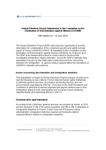Global Detention Project Submission to the Committee on the Elimination of Discrimination against Women (CEDAW)
64th session (4 – 22 July 2016)
The Global Detention Project (GDP) welcomes the opportunity to provide information for consideration of the combined seventh and eighth periodic report of France (CEDAW/C/FRA/7- 8) submitted to the Committee on the Elimination of Discrimination against Women (CEDAW) on 20 March 2014. The GDP is an independent research centre based in Geneva that investigates immigration-related detention. As per the GDP’s mandate, this submission focuses on the State party’s laws and practices concerning detention for immigration – or asylum-related reasons within the framework of CEDAW’s mandate and practices.
Issues concerning discrimination and immigration detention
This submission is based on Global Detention Project research as well as on reports following on-site visits by French national human rights institutions (Contrôleur general des lieux de privation de liberté(CGLPL)) and non-governmental organisations (NGOs).[1] It focuses on the legal framework and conditions of detention of women migrants and asylum seekers due to their immigration status in both metropolitan and overseas French territories (départements) and addresses articles 2 and 15.
Overview and Legal framework
According to the Contrôleur général des lieux de privation de liberté, in 2016 women represent 3.2% of the penal population and 5% to 6% of detainees in immigration detention in France. France has one of Europe’s oldest administrative immigration detention regimes and presents distinct characteristics in relation to immigration detention.
While under European Union law, the Return Directive, member states can detain unauthorized migrants for up to 18 months French immigration law limits such administrative detention to a maximum of 45 days. A fundamental principle in the law is that foreigners can only be placed or kept in custody for the time strictly necessary for their return (Code de l’entrée et du séjour des étrangers et du droit d’asile/CESEDA Article L. 554-1). According to non-governmental sources, immigration detainees actually spent an average of 12.3 days in detention in metropolitan France (and around two days in French overseas territories) in 2014. In the meantime, France detains a record number of unauthorized migrants with nearly 50,000 foreign administrative detainees in 2014 (24,072 detained in Metropolitan France and 21,322 in overseas territories including 19,810 detained at the Pamandzi detention centre in Mayotte, an island in the Comoros archipelago).
French immigration law (CESEDA) has long provided for NGO access to and presence in immigration detention facilities (centres de retention/CRAs). Five NGOs were accredited for five years in 2014 by the Interior Ministry to provide legal aid and social assistance to immigration detainees including La Cimade, France Terre d’Asile, Ordre de Malte, Forum Réfugiés and Assfam. They jointly publish an annual report highlighting national detention laws, statistics and practices within each detention facility.
Under French immigration law Mayotte has a special status and the French Constitution authorizes important derogations with respect to immigration detention. The French Contrôleur general des lieux de privations de libertés and NGOs have denounced serious abuses of human rights, constant overcrowding and lack of procedural safeguards in Mayotte.
Priority issues in relation to women detained based on immigration status:
- According to the CGLPL no specific provision for the reception of women are provided for in the legal framework for the CRAs. Only Article R. 553-3 (10) of the Code of Entry and Residence of Foreigners and Asylum (CESEDA) recalls the prohibition of mixing men and women within detention rooms, except for families. CGLPL visits to various CRAs indicate that organization (management) differs from one CRA to another. In some facilities, a strict separation of men and women was observed for overnight accommodation (the few women being mixed with the male population during the day); conversely, during the visit of CRA in Lyon, inspectors found that the women sector could not be separated from men and thus, women were locked in their rooms at night, in the south wing for women and families;
- Health concerns for pregnant women in detention including higher incidences of miscarriage in detention; lack of access to women’s hygiene kits in detention centres (CRAs) and especially in transit zones (see below);
- In airport transit zones (zones d’attentes), in particular at Roissy and Orly airports, concerns over access to medical care for pregnant women and girls; no gender segregation while detained; women detainees searched by men guards;
- As only nine out of 25 immigration detention centres include spaces for detention of women the CGLPL maintains that this might negatively impact family links while women are placed in immigration detention;
- CGLPL recommendations for separate accommodation for single women;
- CGPL recommendations to pay particular attention to the situation of women detainees to avoid perceptions of insecurity;
- Access to collective recreation for women detainees in Guadeloupe CRA conditional upon a special authorization while it is free for men detainees;
- Follow up to allegations of police brutality (follow up to Anafé’s complaint to the Interior Ministry and CGLPL following allegations of police abuse of six Latin American women in February 2014).
[1] Global Detention Project on-line database including « detention centres, statistics and domestic law, » https://www.globaldetentionproject.org/countries/europe/france ; Contrôleure générale des Lieux de privation de Liberté, « Avis du 25 janvier 2016 relatif à la situation des femmes privées de liberté, » Journal officiel de la République Française, 18 February 2016, http://www.cglpl.fr/2016/avis-relatif-a-la-situation-des-femmes-privees-de-liberte/ ; Assfam, Forum Réfugiés, France terre d’asile, La Cimade et l’Ordre de Malte, « Rapport 2014 sur les centres et locaux de rétention administrative, » 29 June 2015. http://www.lacimade.org/publication/rapport-2014-sur-les-centres-et-locaux-de-retention-administrative/ and « Rapport 2014 sur les centres et locaux de rétention administrative, » http://www.france-terre-asile.org/images/stories/publications/pdf/Centres_et_locaux_de_r__tention_administrative-rapport_2013.pdf ; Anafé, « Des zones d’atteintes aux droits, » 20 January 2016. http://www.anafe.org/spip.php?article317 –



